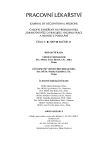Significance of measuring skin temperatures in diagnostics of the Raynaud syndrome from vibrations
Authors:
P. Malenka
Authors‘ workplace:
Klinika pracovního lékařství FN u sv. Anny a LF MU Brno, přednosta prof. MUDr. Petr Brhel, CSc.
Published in:
Pracov. Lék., 61, 2009, No. 4, s. 172-175.
Category:
Original Papers
Overview
The aim of the paper is to describe the significance of skin termometry in diagnostics of the secondary Raynaud syndrome from vibrations. Skin temperatures of patients with the Raynaud syndrome – divided to groups No. 1, 2 and 3 according to the results of plethysmography – will be compared to a control group, at 0 and 20th minute after a chill test. The value of median of skin temperatures of 8 measured fingers is used for the statistical analysis and comparisons.
Key words:
Raynaud syndrome, skin temperatures, plethysmography, occupational disease
Sources
1. BENEŠOVÁ, E. Význam měření kožních teplot – objektivní neinvazivní vyšetření v diagnostice profesionální traumatické vazoneurózy. Brno: Klinika pracovního lékařství, FN u sv. Anny, 2003, 34 s.
2. BOGADI-ŠARE, A., ZAVALIČ, M. Diagnostic value of finger thermometry and photoplethysmography in the assessment of hand-arm vibration syndrome. Int. Arch. Occup. Envir. Health, 1994, č. 60, p. 137–140
3. BRHEL, P. Pracovní lékařství: Základy primární pracovnělékařské péče. 1. vydání. Brno: NCO NZO 2005, 338 s., ISBN 80-7013-414-3.
4. BRHEL P., ŘÍHOVÁ A., BENEŠOVÁ E. Traumatická vazoneuróza po ohlášení nemoci z povolání. Pracov. Lék., 2001, 53, s. 153–157.
5. CHERNIACK, M. et al. Skin temperature recovery from cold provocation in workers exposed to vibration: a longitudinal study. Occup. Envir. Med., 2003, 60, s. 962–968.
6. HŮZL, F., TVRZKÝ, J., SMOLÍKOVÁ, I. Metoda kožní termometrie v diagnostice onemocnění cév z vibrací. Pracov. Lék., 2001, 53, s. 118–128.
7. TAYLOR, W. The hand-arm vibration syndrome-diagnosis, assessment and objective tests: a review. Journal of the Royal Society of Medicine, 1993, 86, s. 101–103.
8. WIGLEY, F. M. Raynald’s phenomenon. NEJM, 2002, 347, s. 1001–1009.
Labels
Hygiene and epidemiology Hyperbaric medicine Occupational medicineArticle was published in
Occupational Medicine

2009 Issue 4
Most read in this issue
- Risk factors at work in the bakery
- Working positions – experience from the practice of physiological measurements
- Noise as a risk factor in school facilities
- Significance of measuring skin temperatures in diagnostics of the Raynaud syndrome from vibrations
